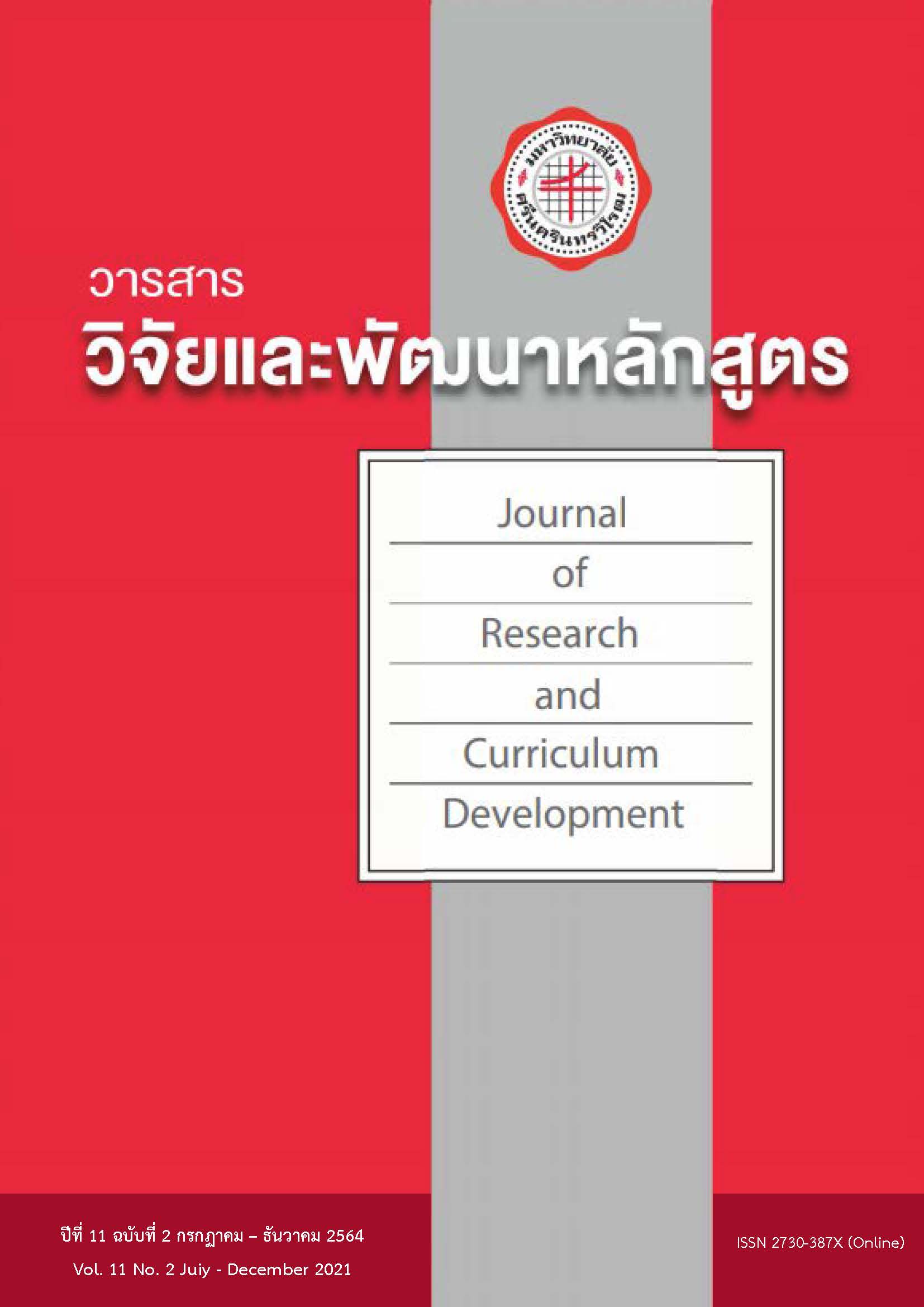การพัฒนารูปแบบการจัดการเรียนรู้และบทเรียนที่สอดคล้องกับวิถีชีวิตผู้เรียนบนเส้นทางเศรษฐกิจการท่องเที่ยว จังหวัดกาญจนบุรี โดยใช้หลักการทรงงานของพระบาทสมเด็จพระเจ้าอยู่หัวสำหรับสถานศึกษาขั้นพื้นฐาน
Keywords:
Key Word: Learning Management Model, Lesson Consistent with the Learner’s Way of Life, King Working StyleAbstract
This research aims to: (1) identify the requirements and the factors of learning management and the lesson consistent with the learner’s way of life on Kanchanaburi touristic economic route, (2) develop the learning management model and the lesson, (3) identify the implementation results of the learning management model and the lesson, and (4) synthesize the implementation results of the learning management model and the lesson, along with the extension of the results. The findings were: (1) all sectors recognized the importance and wanted to develop the model and the lesson learning management. There were 4 factors of the learning management that consists of: (1) the teacher, (2) the learner, (3) the curriculum and the lesson, and (4) the learning activity. (2) the result of the development of the learning management model were effective at the significance level of 0.05 which consist of 5 steps: (1) define the way of learning according to the way of life, (2) analyze the way of life by using the King working style, (3) find the answers by using the King working style, (4) analyze and refine the data, and (5) present the learning results. (3) The results of using the learning management model and the lesson were as follows: (3.1) the overall average of teachers' learning management ability categorized by the classes was at moderate level, (3.2) learners' learning outcomes of Prathomsuksa 1 to Matthayomsuksa 3 learners, the post - test was higher than the pre - test, with the significance level at 0.05, (3.3) the average of the ability to analyze of the learner’s way of life was at moderate level, and (3.4) the average of the awareness of the learner’s way of life was at moderate level. (4) the synthesis after using the learning management model, the lesson activities were optimized, and expanded to teachers and students in local schools. The results of using were moderate and effective at the significance level of 0.05.
References
จันทร์เพ็ญ สุวรรณคร. (2559). กระบวนทัศน์การจัดกิจรรมแนะแนวเพื่อเสริมสร้างการใช้ทักษะชีวิตและอาชีพของนักเรียนชั้นมัธยมศึกษาตอนปลาย. วารสารศิลปากรศึกษาศาสตร์วิจัย. ปีที่ 8 ฉบับที่ 2 (กรกฎาคม-ธันวาคม 2559) หน้าที่ 176-191.
ชัยยงค์ พรหมวงศ์. (2539). องค์ประกอบของการจัดการเรียนการสอน. เอกสารการสอนชุดวิชาเทคโนโลยีการสอน หน่วยที่ 9-15. นนทบุรี: โรงพิมพ์มหาวิทยาลัยสุโขทัยธรรมาธิราช.
ปพนวัจน์ ลภัสภิญโญโชค. (2559). การพัฒนารูปแบบการเรียนการสอนเพื่อส่งเสริมมโนทัศน์และกระบวนการทางคณิตศาสตร์สำหรับนักเรียนระดับประถมศึกษา. วารสารศิลปากรศึกษาศาสตร์วิจัย. ปีที่ 8 ฉบับที่ 2 (กรกฎาคม-ธันวาคม 2559) หน้าที่ 205-218.
พรชัย หนูแก้วและศุภลักษณ์ สัตย์เพริศพราย. (2561). การใช้กระบวนการวิจัยแบบมีส่วนร่วมในการพัฒนานวัตกรรมการเรียนรู้โดยใช้แหล่งเรียนรู้ในท้องถิ่นสำหรับครูเพื่อพัฒนาผู้เรียนในจังหวัดกาญจนบุรี. คณะครุศาสตร์ มหาวิทยาลัยราชภัฏกาญจนบุรี.
เพ็ญศรี ฉิรินัง. (2558). แนวทางการพัฒนาศักยภาพการท่องเที่ยว จังหวัดกาญจนบุรี. วารสารวิจัยมหาวิทยาลัยเวสเทิร์น มนุษย์ศาสตร์และสังคมศาสตร์. ปีที่ 1 ฉบับที่ 1 (มกราคม-เมษายน 2558) หน้า 1-14.
ศิริชัย กาญจนวาสี และคณะ. (2558). ยุทธศาสตร์การกระจายอำนาจการจัดการศึกษา.กรุงเทพฯ : สำนักงานเลขาธิการสภาการศึกษา.
สาโรจน์ เผ่าวงศากุล. (2560). การพัฒนาหลักสูตรกิจกรรมลดเวลาเรียนเพิ่มเวลารู้ตามแนวสะเต็มศึกษาเพื่อพัฒนาทักษะชีวิตและอาชีพของผู้เรียนกรณีศึกษา โรงเรียนบ้านหาดงิ้ว อำเภอไทรโยค จังหวัดกาญจนบุรี. คณะครุศาสตร์ มหาวิทยาลัยราชภัฏกาญจนบุรี.
สุเทพ อ่วมเจริญ. (2557). การพัฒนาหลักสูตร: ทฤษฎีและการปฏิบัติ. นครปฐม: ศึกษาศาสตร์ มหาวิทยาลัยศิลปากร.
อัชรา เอิบสุขสิริ. (2556). จิตวิทยาสำหรับครู. กรุงเทพฯ: บริษัท วี พริ้น (1991) จำกัด.
สำนักงานเลขาธิการสภาการศึกษา. 2552. ข้อเสนอการปฏิรูปการศึกษาในทศวรรษที่สอง (พ.ศ. 2552-2561).
กรุงเทพมหานคร : บริษัท พริกหวานกราฟฟิค จำกัด.
_______. (2559). สมรรถนะการศึกษาไทยในเวทีสากล พ.ศ. 2558. กรุงเทพฯ: พริกหวาน กราฟิค.
Anderson T.P., (1997). Using model of Instruction. Englewood Cliffs, NJ : Education Technology Publications.
Arends. (1998). Learning to Teach. 4th ed. Singapore: The McGraw-Hill.
Dick, W. & Carey, L.M. (1978, 1985, 1990, 1996).The systematic design of instruction. New York: HarperCollins.
Gagne, R. M., Briggs, L. J., & Wager, W. W. (1992). Principles of Instructional Design (4th ed.). Orlando: Harcourt Brace Jovanovich.
Joyce, B., M. Weil and E. (2009). Model of Teaching. 8th ed. London: Ally and acon.
Vygotsky, L.S., (1978). Mind in social: The development of Higher psychological process. Cambridge, MA: Harvard University Press.





